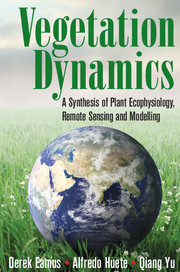Book contents
- Frontmatter
- Contents
- Preface
- Section One Plant Ecophysiology
- Section Two Remote Sensing
- Section Three Modelling
- Section Four Case Studies
- 14 Boreal Forests
- 15 Arid and Semi-Arid Grasslands
- 16 Savannas
- 17 Seasonal Behaviour of Vegetation of the Amazon Basin
- 18 Tropical Montane Cloud and Rainforests
- 19 Groundwater Dependent Ecosystems
- 20 Global-Change Drought and Forest Mortality
- Index
- References
15 - Arid and Semi-Arid Grasslands
from Section Four - Case Studies
Published online by Cambridge University Press: 05 June 2016
- Frontmatter
- Contents
- Preface
- Section One Plant Ecophysiology
- Section Two Remote Sensing
- Section Three Modelling
- Section Four Case Studies
- 14 Boreal Forests
- 15 Arid and Semi-Arid Grasslands
- 16 Savannas
- 17 Seasonal Behaviour of Vegetation of the Amazon Basin
- 18 Tropical Montane Cloud and Rainforests
- 19 Groundwater Dependent Ecosystems
- 20 Global-Change Drought and Forest Mortality
- Index
- References
Summary
Introduction
Grasslands are a major biome globally and are found on all continents except Antarctica. The dominant life form is grasses, a highly adaptable group of plants showing both annual and perennial life histories and using C3 and C4 photosynthetic pathways (Chapter 2). Because of this wide amplitude in life histories they can be found in cold (sub-zero annual average temperatures), temperate and tropical climates across a wide range of annual rainfall (300 mm to more than 1500 mm) (e.g. Fig. 15.1). Rainfall is often (but not always) highly seasonal and disturbance by fire a common feature. Grasslands can grade into savannas where rainfall is sufficient to support woody shrubs or trees, or they grade into deserts where rainfall is insufficient to support extensive plant life. Temperate grasslands experience larger seasonal amplitude in temperature than observed in tropical grasslands and savannas. Veldts in South Africa, steppes of Russia, The Mitchell Plains grasslands of northern Australia, Pampas grasslands of South America and the prairies of central North America are examples of grasslands: all support significant numbers of grazing animals, both farmed and unmanaged.
In this case study, we focus exclusively on fluxes of C (productivity) because these are the most important fluxes in terms of management of rangelands in arid and semi-arid landscapes, where water fluxes are very much linked to C fluxes.
Intra-Annual Patterns of Carbon Flux in Grasslands
Dormant periods when grass growth is absent is a common feature of arid and semi-arid grasslands, when lack of rain and/or low temperatures, inhibit growth. The onset of spring rains and increased temperatures are associated with increased grass growth resulting in increased LAI, light interception and NPP. Figure 15.2 shows how soil temperature increases through spring and summer (months 4−9) and, at this site, volumetric soil moisture content declined in the early spring because of rapid increases in LAI during the early spring growth period with little rainfall. Rainfall in August and September increased soil moisture content in the latter half of the summer.
Increased temperatures and a high soil moisture content in spring result in increasing grass growth and increasing rates of NEE (larger negative values indicate increased rates of C uptake) and this was associated with non-linear increased rates of soil respiration. A time-lag of increased NEE resulting in increased rates of autotrophic soil respiration of four to six days generally occurs, as discussed in Chapter 2.
- Type
- Chapter
- Information
- Vegetation DynamicsA Synthesis of Plant Ecophysiology, Remote Sensing and Modelling, pp. 368 - 382Publisher: Cambridge University PressPrint publication year: 2016



